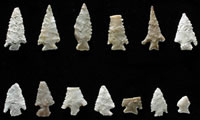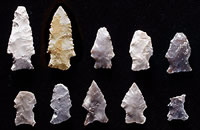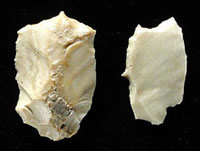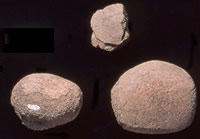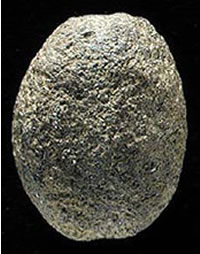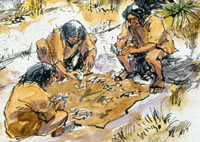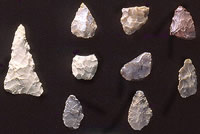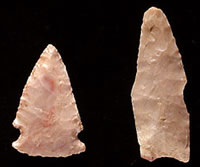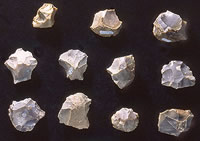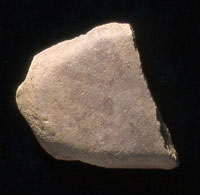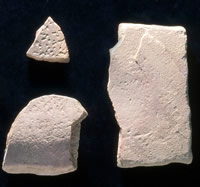Artifacts from the Rancheria |
||
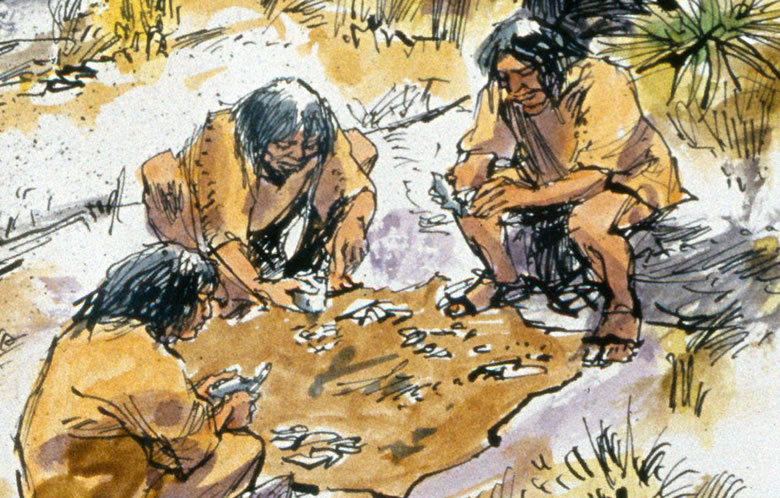 |
||
|
When the Austin phase people abandoned their rancheria, they left behind thousands of artifacts, the tools and other objects they made or collected while in residence there and lots of plain old trash—stone tool-making debris, spent hearth stones, and organic waste. The artifacts they left behind were the things they no longer wanted or needed or were too heavy to carry off with them. Most of what they left can no longer be found in the ruins of the rancheria. All the artifacts of wood, fiber, and leather which no doubt littered the settlement, have long since disintegrated. Almost all the bone, and perhaps most of the mussel shell as well, have been destroyed by the processes of nature. We are left, to a large extent, with just the artifacts made of stone to help us reconstruct how these people lived. By far, the most numerous stone artifacts recovered were the waste flakes from stone tool making (debitage), many of which were found in an area we describe as the lithic workshop area. It seems possible that much of the tool making at the rancheria took place in this area, away from the dwellings and cooking fires. Of the actual tools, the vast majority are simple unmodified flint flakes which would have been used for cutting or scraping and then thrown away when dulled or no longer needed. More elaborate, carefully shaped tools such as scrapers and bifaces had a longer use life and have been recovered in very small numbers. Most of these "formal" tools broke while being made or used and were discarded. Many were reworked (resharpened or reshaped) to the point that they were no longer useful. Occasionally a cherished and still useful item, such as the expertly knapped arrow point preform excavated from a unit north of the midden, was lost amid the camp refuse or high grass around the site. Other items may have been left behind purposefully with the thought that the group might return to this spot and reclaim them during another visit. Arrow PointsDozens of small, thin, chipped-stone points that once tipped arrows have been recovered from the Graham-Applegate excavations. All but two points are of the Scallorn type, one of the archeological signatures of the central Texas Austin phase. From A.D. 700 to 1350, these points were distributed throughout much of the state. Although classified as Scallorn, the Graham-Applegate points vary slightly in shape or style. Some of these differences result from the idiosyncrasies of the individual knapper, while other style characteristics may have been developed and shared by the culture through time. For example, the stems of the points from Houses 1 and 2 are longer and narrower than the stems of later Scallorn points. We also need to take into account that broken points were often reworked into serviceable projectile tips or possibly other tools. The two points that do not fit the Scallorn style likely were made during the Austin phase as well. This includes the Sabinal point more common to the Austin phase people who lived in the southern and southwestern area of the Edwards Plateau, and another point which is difficult to type, but may be a late variant of the Scallorn type. Arrow Point Blanks and PreformsTo make an arrow point, the knapper first struck off a thin, flat flake or "blank" from a large chunk of flint (core) or biface. The blank was then thinned further and shaped by systematically applying pressure to the edges with an antler tip to remove very small flakes from both faces of the blank, turning it into an arrow point preform. The preform was further thinned and shaped with pressure flaking, resulting in a very thin, symmetrical, triangular point. The final step was to form notches by careful pressure-flaking inward from the corners of the base, thus forming barbs and creating an expanding stem for hafting on the arrow shaft. Blanks and preforms from all stages of manufacture have been found in Graham-Applegate. Most of these were recovered from the lithic workshop area on the southern edge of the site, where the male hunters likely sat and flaked stone tools (as conceptualized in the drawing, above). Dart PointsA small number of dart points uncovered at the rancheria are of styles that were in use hundreds and even thousands of years before the Austin phase. One late Paleoindian point—nearly 10,000-years old—was found just outside of House 4. The presence of these early points may mean that the site was occupied on brief occasions during the Archaic period and earlier. It does not seem that any of these early stays were long or "intense" because in most cases only one example of each point type has been found. A more likely explanation might be that the Austin phase inhabitants collected these points from the older Archaic sites in the vicinity of the rancheria, such as 41LL413 located a few hundred meters to the west on the far side of the arroyo. We know that older artifacts, such as certain bifaces, were brought into the rancheria and reworked into new tools. In the process, flakes were removed that exposed the unweathered flint beneath the old flaked surface that had developed a patina. A more significant number of dart points recovered from Graham-Applegate seem to belong to a single type, a type that resembles the Late Archaic Darl point. These are long, slender points with distinct shoulders but no barbs. They are relatively thick and heavy and probably were not used to tip arrows. While it is possible they were left behind during a Late Archaic occupation of the area, it seems more likely—based on their distribution (and their depth in the site deposits)—that they were part of the Austin-phase use of the site. Both the "Darl-like" points and Scallorn arrow points and preforms were found in and just outside the floor of House 1. In other sites in central Texas, both Scallorn points and Darl or Darl-like points have been found together in contexts that strongly suggest they were in use at the same time by the same cultural group. For example, at the Pat Parker site near Austin, Scallorn points were found with Darl points in burials. What this tells us is that Austin phase folk likely were hunting with two types of weapons systems—the bow and arrow and the more-ancient spear thrower, or atlatl, which propelled dart heads such as these (see From Dart to Arrow). Bifaces"Biface" really has several meanings—one is simply any stone artifact where flakes have been removed from both faces or sides. For example, almost all projectile points are bifaces in this sense. A biface can also mean a type of knife-like, general-purpose cutting tool with bifacial flaking. Austin phase knappers made many small bifaces; some of these may actually be dart point preforms or other unfinished tools. We know from the flaking debris or debitage that some fairly large, thin bifaces were also made at the rancheria, but no complete specimens have been found. Undoubtedly, large bifacial knives were highly prized possessions that were not discarded until broken. CoresStone-tool making was a major endeavor at the rancheria, and it is not surprising that many cores (blocky chunks of flint from which flakes were removed) have been found there, especially in the lithic workshop area on the south end of the site. The cores began as river cobbles and gravels collected from the Llano River and its terraces, and perhaps from sources farther away. These cobbles were first tested where they were found by knocking off a few flakes to reveal the quality of flint beneath the rough outer cortex. Cobbles that passed the test were brought back to the rancheria and used as cores, a ready source of flakes which could be used without further modification as simple cutting tools. Some flakes would be further fashioned into more formal tools such as scrapers. Sometimes cores themselves could become "heavy duty" tools or "choppers" when a suitable edge was flaked on them. There is little evidence of this at the rancheria as only one core seems to have been used as chopper. Micro-CoresVery small cores, or micro-cores, occur in significant numbers at the rancheria. These present a puzzle because tiny flakes were being struck from them, flakes too small to be used as arrow point blanks. Perhaps the small flakes were used in groups to make composite tools. For example, a series of small flakes could be inserted into a groove along a wooden stick or piece of antler to make a long-edged, serrated cutting tool. These small flakes also could have been used singly in delicate cutting or scraping tasks. ScrapersThese tools are not commonly found at many Austin phase sites, and they are comparatively rare at the Graham-Applegate rancheria. Less than half-a-dozen have come to light during the excavations, which is unusual for such a useful and easily made tool. It is possible that simple unworked flakes were used for scraping tasks. Of the few scrapers that were found, several were large and well-made and were found on the floors of Houses 2 and 3 and against the outside wall of House 1. Painted PebblePainted pebbles are rarely seen at open campsites because the paint usually is washed away by hundreds of years of rainfalls. Remarkably, a painted pebble was found at Graham-Applegate on the eastern side of the site near a hearth dated to the fourteenth century A.D. The fact that the pebble was deposited in the ground with the painted designs facing downward no doubt had something to do with its preservation. Although the designs have faded and are difficult to make out, they appear to consist of several wide parallel lines in red paint on the smooth surface of a water-worn sandstone cobble. Painted pebbles have been found in the Austin phase occupation layer at Kyle Rockshelter in Hill County and at Scorpion Cave in Medina County (which has a substantial Austin phase component). Painted pebbles are fairly common finds in rockshelters and other protected areas of the Lower Pecos region (see The Painted Pebble Cache in the Bonfire exhibit for more discussion). Groundstone ToolsGroundstone tools made by grinding, battering, and pecking have been found in all parts of the Graham-Applegate site. These include whole and fragmentary granite manos (hand stones) and sandstone metate (slabs with grinding facets) fragments. Most if not all of these artifacts were recycled as heating stones in the large central hearths of the houses and the smaller outdoor hearths or fireplaces. Many highly burned fragments of groundstone artifacts also were recovered from the burned rock midden and undoubtedly were used to line the baking pit. A large metate fragment and several manos had been used in the wall supports of House 1. Normally used for grinding seeds into flour, manos and metates from Graham-Applegate have not been found in any context that would lead us to conclude they were being used there to process food. Even the few serviceable manos that were not recovered from burned rock features or from wall supports showed evidence of having been burned. One perfectly good mano was even recovered from the bottom of the central hearth in House 1. It seems as though the inhabitants of the rancheria had little need for such implements and were probably consuming foods that did not require grinding. Alternatively, they may have taken the still serviceable milling stones with them. The rancheria people might have picked up these grinding stones from old Archaic campgrounds in the area where even today such artifacts are fairly common. Grooved stoneAn unexpected find was an egg-shaped piece of sandstone with a shallow groove pecked lengthwise around it. Similar grooved stones, along with the notched stones called "Waco sinkers," have been dated to Late PaleoIndian and Early Archaic times, thousands of years before the rancheria existed. Like the early dart points, this grooved stone could be something that was found elsewhere and brought back to the settlement as a curiosity. |
||
